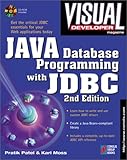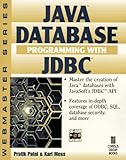Pratik Patel
Pratik Patel is the CTO of Atlanta based TripLingo (http://www.triplingo.com/). He wrote the first book on 'enterprise Java' in 1996, "Java Database Programming with JDBC." He has also spoken at various conferences and participates in several local tech groups and startup groups. He's in the startup world now and hacks iOS, Android, HTML5, CSS3, JavaScript, Rails, and ..... well everything except Perl. Pratik's specialty is in large-scale applications for mission-critical and mobile applications use. He has designed and built applications in the retail, health care, financial services, and telecoms sectors. Pratik holds a master's in Biomedical Engineering from UNC, has worked in places such as New York, London, and Hong Kong, and currently lives in Atlanta, GA.
Presentations
Enterprise JPA & Spring 3.0 - Tips and Tricks for JEE Persistence
As with many technologies, the basics are easy. The hard part comes when the developer needs to do sophisticated integration, development, and testing as part of an enterprise application. A large enterprise application requires the developer to think of issues that affect the development, scalability and robustness of the application. This presentation will cover the advanced topics described below with a focus on the new persistence features in Spring 3.0 and JPA 2.0.
A large enterprise application often will have several sub-projects that each contain their own JPA persistence unit. This opens up a number of questions around how to organize the persistence units and how the code between sub-projects should interoperate. Developers will gain insight into these issues and will see a couple of solutions using live code examples.
Many enterprise applications require integration with an application server's JTA mechanism. JTA integration allows for JPA components to work with container managed transactions and distributed transactions. A typical usage scenario for JPA & JTA is this: read from a database using JPA, perform some business logic, put a message on a queue, write to the database (again using JPA). A JTA transaction allows you to ensure that the entire set of operations is committed or a rollback is performed. In this presentation, the developer will understand the limitations and configuration of using JTA and JPA together ? primarily through real code examples.
Once unit tests are written, developers often gloss over doing fine-grained integration testing just for their persistence layer. Integration testing with JPA means simply one thing: running your JPA components against your target database, for example, Oracle. Overlooking this aspect leads to problems being discovered later in the test cycle (UAT for example) and makes it more difficult to find and fix bugs. This presentation will use live code examples to explain a strategy for getting integration testing for free by reusing unit tests.
Using optimistic locking versus pessimistic locking seems clear cut to most developers. However, a full understanding of the issues with using pessimistic, or datastore, locking is required before making this decision. Developers will get information in the trade offs when using strategy or the other, and how these strategies can be used together with the same persistence unit.
Books
by Pratik Patel and Karl Moss
-
Java Database Programming with JDBC by Pratik Patel and Karl Moss is an updated edition of the authors' guide to the Java Database Connectivity (JDBC) standard for database programming under Java. While the original edition was perhaps geared more to those developers who needed to write their own JDBC database drivers, a fairly arduous task, this new edition provides more background information on database connectivity issues in Java and so will be even more useful to the casual or intermediate programmer. After a general introduction to JDBC and Structured Query Language (SQL), useful even to beginning programmers, the authors start by building a simple database-aware applet. New chapters on "servlets," Java components that run on the server-side and manage database operations, as well as a general discussion of middleware technologies are particularly good. Database access for JavaBean components (from Sun Microsystems JDK 1.1) is also discussed, including working code for two database-aware beans. This book also includes a quick introduction to the Java language (which will only be helpful if you already know C/C++), a detailed reference for the JDBC API, and a working example of a text-based JDBC driver. Though this book is still oriented toward the JDBC driver developer, the authors now provide enough general discussion of JDBC architectural issues to make it worthwhile to any programmer who needs to ramp up on what JDBC is and what capabilities it offers.
- Java Database Programming with JDBC by Pratik Patel and Karl Moss is an updated edition of the authors' guide to the Java Database Connectivity (JDBC) standard for database programming under Java. While the original edition was perhaps geared more to those developers who needed to write their own JDBC database drivers, a fairly arduous task, this new edition provides more background information on database connectivity issues in Java and so will be even more useful to the casual or intermediate programmer. After a general introduction to JDBC and Structured Query Language (SQL), useful even to beginning programmers, the authors start by building a simple database-aware applet. New chapters on "servlets," Java components that run on the server-side and manage database operations, as well as a general discussion of middleware technologies are particularly good. Database access for JavaBean components (from Sun Microsystems JDK 1.1) is also discussed, including working code for two database-aware beans. This book also includes a quick introduction to the Java language (which will only be helpful if you already know C/C++), a detailed reference for the JDBC API, and a working example of a text-based JDBC driver. Though this book is still oriented toward the JDBC driver developer, the authors now provide enough general discussion of JDBC architectural issues to make it worthwhile to any programmer who needs to ramp up on what JDBC is and what capabilities it offers.
by Pratik Patel and Karl Moss
-
Java Database Programming with JDBC by Pratik Patel and Karl Moss is an updated edition of the authors' guide to the Java Database Connectivity (JDBC) standard for database programming under Java. While the original edition was perhaps geared more to those developers who needed to write their own JDBC database drivers, a fairly arduous task, this new edition provides more background information on database connectivity issues in Java and so will be even more useful to the casual or intermediate programmer. After a general introduction to JDBC and Structured Query Language (SQL), useful even to beginning programmers, the authors start by building a simple database-aware applet. New chapters on "servlets," Java components that run on the server-side and manage database operations, as well as a general discussion of middleware technologies are particularly good. Database access for JavaBean components (from Sun Microsystems JDK 1.1) is also discussed, including working code for two database-aware beans. This book also includes a quick introduction to the Java language (which will only be helpful if you already know C/C++), a detailed reference for the JDBC API, and a working example of a text-based JDBC driver. Though this book is still oriented toward the JDBC driver developer, the authors now provide enough general discussion of JDBC architectural issues to make it worthwhile to any programmer who needs to ramp up on what JDBC is and what capabilities it offers.
- Java Database Programming with JDBC by Pratik Patel and Karl Moss is an updated edition of the authors' guide to the Java Database Connectivity (JDBC) standard for database programming under Java. While the original edition was perhaps geared more to those developers who needed to write their own JDBC database drivers, a fairly arduous task, this new edition provides more background information on database connectivity issues in Java and so will be even more useful to the casual or intermediate programmer. After a general introduction to JDBC and Structured Query Language (SQL), useful even to beginning programmers, the authors start by building a simple database-aware applet. New chapters on "servlets," Java components that run on the server-side and manage database operations, as well as a general discussion of middleware technologies are particularly good. Database access for JavaBean components (from Sun Microsystems JDK 1.1) is also discussed, including working code for two database-aware beans. This book also includes a quick introduction to the Java language (which will only be helpful if you already know C/C++), a detailed reference for the JDBC API, and a working example of a text-based JDBC driver. Though this book is still oriented toward the JDBC driver developer, the authors now provide enough general discussion of JDBC architectural issues to make it worthwhile to any programmer who needs to ramp up on what JDBC is and what capabilities it offers.
by Pratik R. Patel, Alan D. Hudson, and Donald A. Ball
-
Enables readers to master the Java programming language for internet applications while expanding the scope of online development, and the accompanying CD contains powerful sample applets and a copy of Netscape Navigator. Original. (Intermediate).
- Enables readers to master the Java programming language for internet applications while expanding the scope of online development, and the accompanying CD contains powerful sample applets and a copy of Netscape Navigator. Original. (Intermediate).
- NFJS SITES:
- No Fluff Just Stuff
- Uber Conf
- NFJS One
- SpringOne 2GX
- Rich Web Experience
- Continuous Delivery Experience
- SPRINGSOURCE SITES:
- Springsource.com
- Springsource.org








